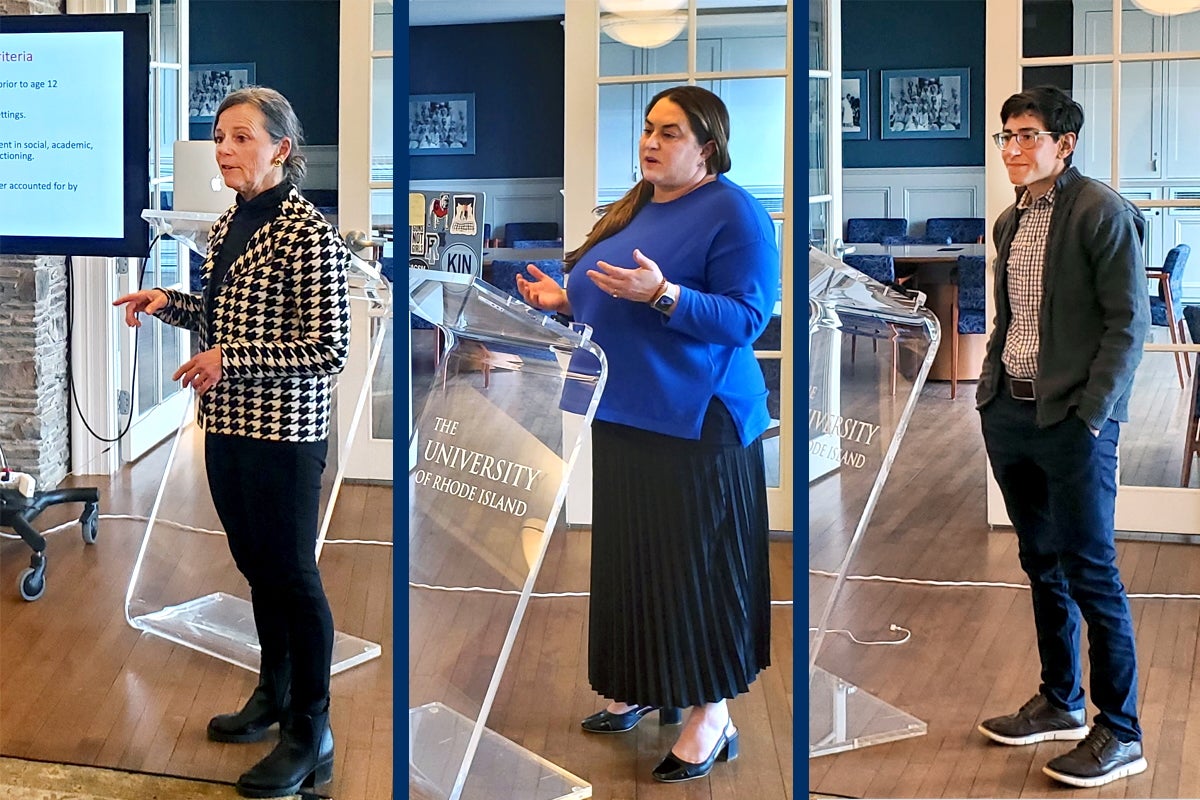Lisa Weyandt, Jillian Scheer, and Christie Ward-Ritacco described their work in neuroscience, psychology, and kinesiology, respectively
The College of Health Sciences periodically holds faculty research nights for professors to speak about their research studies. In URI’s Alumni Center on March 27, professors Lisa Weyandt, Jillian Scheer, and Christie Ward-Ritacco shared examples of their research, which reflected their areas of expertise.
Lisa Weyandt, professor, psychology; director, Interdisciplinary Neuroscience Program
Weyandt’s research has largely focused on attention-deficit/hyperactivity disorder (ADHD) and treatment approaches for the disorder.
The professor and her co-principal investigators conducted the first longitudinal study of college students with ADHD. The researchers studied 443 college students from multiple states for almost five years. The results showed students with ADHD had lower grade point averages, poorer study skills, a lower quality of life, higher sexual risk behavior, and a higher use of academic services.
Weyandt is currently conducting four research studies:
- The effectiveness of prescription stimulants at improving neurocognition in patients post-traumatic brain injury with or without ADHD
- If prescription stimulants are misused by military populations
- If “Cocoon therapy” is effective for concussions
- The prevalence of prescription stimulant misuse and the relationship with psychological and demographic variables, which is a multi-site study involving three countries
Weyandt is recognized as one of the leading experts on prescription stimulant misuse.
Jillian Scheer, assistant professor, psychology
Scheer’s presentation was about how stress faced by members of stigmatized minority groups can trigger death-related thoughts and suicidal ideation, and how such thoughts can lead to substance use. The population Scheer studied was sexual minority women (SMW), meaning women who identify as gay, lesbian, bisexual, or queer.
“We found that younger SMW and SMW with insufficient income to meet basic needs were more likely to report death-related thoughts, and passive and active suicidal ideation,” said Scheer.
According to Scheer’s research, passive suicidal ideation was more common among younger sexual minority women and Latinx sexual minority women. Active suicidal ideation was more prevalent among younger sexual minority women and bisexual women. Sexual minority women with greater exposure to trauma and minority stressors were at increased risk of death-related thoughts and passive suicidal ideation. Prospectively, death-related thoughts and passive suicidal ideation increased the risk of alcohol use disorder and cigarette use.
“We concluded that suicide interventions should adopt an intersectional approach to provide inclusive care for at-risk SMW and SMW-specific substance use prevention programs should screen for death-related thoughts and suicidal ideation,” said Scheer.
Scheer’s other studies focus on:
- Intensive longitudinal (e.g., ecological momentary assessment) methods
- Lab-based stress-induction paradigms involving psychophysiological assessments
- Mental health and substance use treatment adaptation, development, and delivery for minoritized groups
Christie Ward-Ritacco, associate professor, kinesiology
The effects physical activity, muscular performance, and body composition have on one’s quality of life was the subject of Ward-Ritacco’s research presentation.
Ward-Ritacco has conducted research on a wide range of age groups and abilities, from high-performing collegiate athletes to active and non-active older adults.
“I work with interdisciplinary teams on research that is focused on physical activity and exercise, nutrition, and behavior modification,” said Ward-Ritacco.
The professor’s current research projects include assessing physical activity, body composition, muscular performance, and quality of life in middle-aged women; and evaluating metabolic responses to active-assisted and traditional cycling in healthy older adults and individuals with Parkinson’s disease.
Ward-Ritacco described some of the methods and equipment used in her laboratory to analyze muscle mass, muscle strength, muscle quality, body composition, and physical performance. She highlighted a research project one of her doctoral students is conducting on how health-related behaviors in young adulthood affect long-term physical health and performance.

